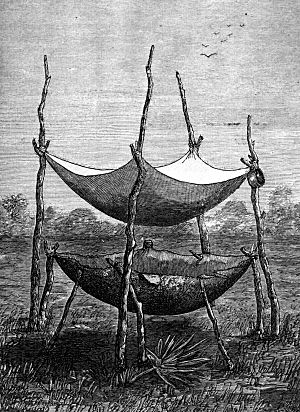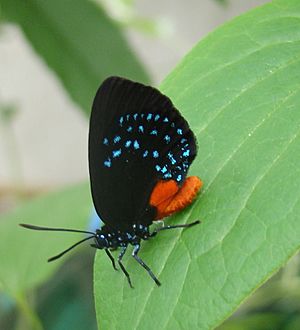Coontie palm facts for kids
Quick facts for kids Coontie palm |
|
|---|---|
 |
|
| Leaves of Zamia integrifolia | |
| Conservation status | |
| Scientific classification | |
| Genus: |
Zamia
|
| Species: |
integrifolia
|
| Synonyms | |
|
List
|
|
Zamia integrifolia is a small, tough plant that looks a bit like a palm or fern. It's a type of cycad, which are ancient plants that have been around since the time of dinosaurs! You can find this plant in the southeastern United States (like Florida and Georgia), the Bahamas, Cuba, the Cayman Islands, Hispaniola (which includes the Dominican Republic and Haiti), and Puerto Rico. Sadly, it might not exist in Puerto Rico and Haiti anymore.
Contents
What Does the Coontie Look Like?
The coontie plant grows reddish cones that hold its seeds. Its leaves can be quite long, from 20 to 100 centimeters (about 8 to 39 inches). Each leaf has many smaller leaflets, usually between 5 and 30 pairs. These leaflets are thin and long, about 8–25 cm (3–10 inches) long and 0.5–2 cm (0.2–0.8 inches) wide. They might have tiny teeth at their tips.
This plant usually grows low to the ground. Its main stem, called a trunk, is often hidden underground. It can grow to be 3–25 cm (1–10 inches) tall. Over time, it forms a big clump with many branches and a large root system that helps it store food.
The coontie is quite tough! If it gets very cold, its leaves might fall off, but the plant stays alive underground in its root system. When the weather warms up, new leaves grow back. This helps the coontie survive in places where it gets chilly, like USDA region 8b.
Like other cycads, Zamia integrifolia plants are either male or female. This means you need both a male and a female plant for them to make seeds. The male cones are shaped like cylinders and are 5–16 cm (2–6 inches) long. Female cones are more oval-shaped and are 5–19 cm (2–7.5 inches) long and 4–6 cm (1.5–2.4 inches) wide.
Coontie: Food or Foe?
Can You Eat It?

Long ago, Indigenous tribes in Florida, like the Seminoles and Tequestas, used the coontie root as a food source. But it wasn't easy! They had to grind the root and then soak it in water overnight. After that, they would rinse it for many hours with running water. This was super important to wash away a natural toxin.
The leftover paste was then left to ferment and dried into a powder. This powder could be used to make a bread-like food. Later, in the late 1800s, some factories in Miami started making a product called Florida arrowroot from coontie, but they stopped after World War I.
Is It Poisonous?
Yes, the entire coontie plant contains a natural toxin called cycasin. If eaten without proper preparation, this toxin can cause serious harm, including liver failure. The seeds also have a toxic substance that can cause headaches, vomiting, stomach pains, and diarrhea if you eat them. Another substance in the seeds can affect your nervous system. That's why it's so important to know that the plant is poisonous unless it's prepared very carefully!
What Are Its Other Names?
This plant has a few different common names. Two names, Florida arrowroot and wild sago, come from its past use as a food source for starch. The name Coontie (or koonti) comes from the Seminole Native American language, where conti hateka means "white flour" or "white bread."
Where Does the Coontie Live?
Zamia integrifolia likes to grow in different places, as long as the soil is sandy and drains water well. It prefers spots where it gets some sunlight but also some shade. Today, you can mostly find it in Florida, southeastern Georgia, central Cuba, and the Dominican Republic. It used to grow in southern Puerto Rico and Haiti too, but it seems to have disappeared from those areas because of how the land was used.
The coontie plant is super important for a special butterfly called the Eumaeus atala. This butterfly was once thought to be extinct, but it was rediscovered! The Eumaeus atala caterpillar can only eat the leaves of the coontie plant. Just a few caterpillars can eat all the leaves off a coontie plant, so a lot of coontie plants are needed to keep the butterfly population healthy.
Another interesting insect found on coontie plants is the Mealybug destroyer (Cryptolaemus montrouzieri). These insects help the coontie by eating pests like scales and mealybugs that can harm the plant. In return, the coontie provides them with food. It's a win-win!
Plant Pests
Even tough plants like the coontie can get pests. Some common ones are Florida red scales, hemispherical scales, and longtailed mealybugs. When these pests attack, the plant's growth can slow down, and it might get covered in a black mold. Often, more than one type of pest can be found on the same plant.
How Coontie Gets Nitrogen
Cycads, including the coontie, are special because they can work with tiny living things called cyanobacteria (a type of bacteria that can make its own food). These bacteria live in special roots of the coontie called coralloid roots. The bacteria help the plant get nitrogen from the air, which is a very important nutrient for plants to grow. It's like the plant has its own little fertilizer factory!
How Does the Coontie Reproduce?
Remember how we said coontie plants are either male or female? Well, the male and female cones (also called strobili) grow on separate plants. The female cones are thick and have red-orange seeds inside. They feel a bit velvety and usually grow up to 15 cm (6 inches) long. Male cones are thinner and taller, holding pollen, and can reach about 18 cm (7 inches) long. Female plants usually have one cone, while male plants often have groups of cones. Coontie plants usually start growing new cones in the spring.
How Coontie Is Pollinated
Zamia floridana plants are pollinated by two types of weevils, which are small beetles: Rhopalotria slossoni and Pharaxonotha floridana.
One type of weevil, P. floridana, helps pollinate the plant by using the male cones (which have pollen) as food for its young. As they move around, they pick up pollen and carry it to the female cones. The plant can even make its seed-bearing cones a bit poisonous to these weevil larvae, which helps control how many weevils are around.
The other weevil, R. slossoni, doesn't eat the pollen. Instead, it hides in the male cones and gets covered in pollen. Then, it flies to the female cones, bringing the pollen with it and helping the plant make seeds.
See also
 In Spanish: Zamia integrifolia para niños
In Spanish: Zamia integrifolia para niños



